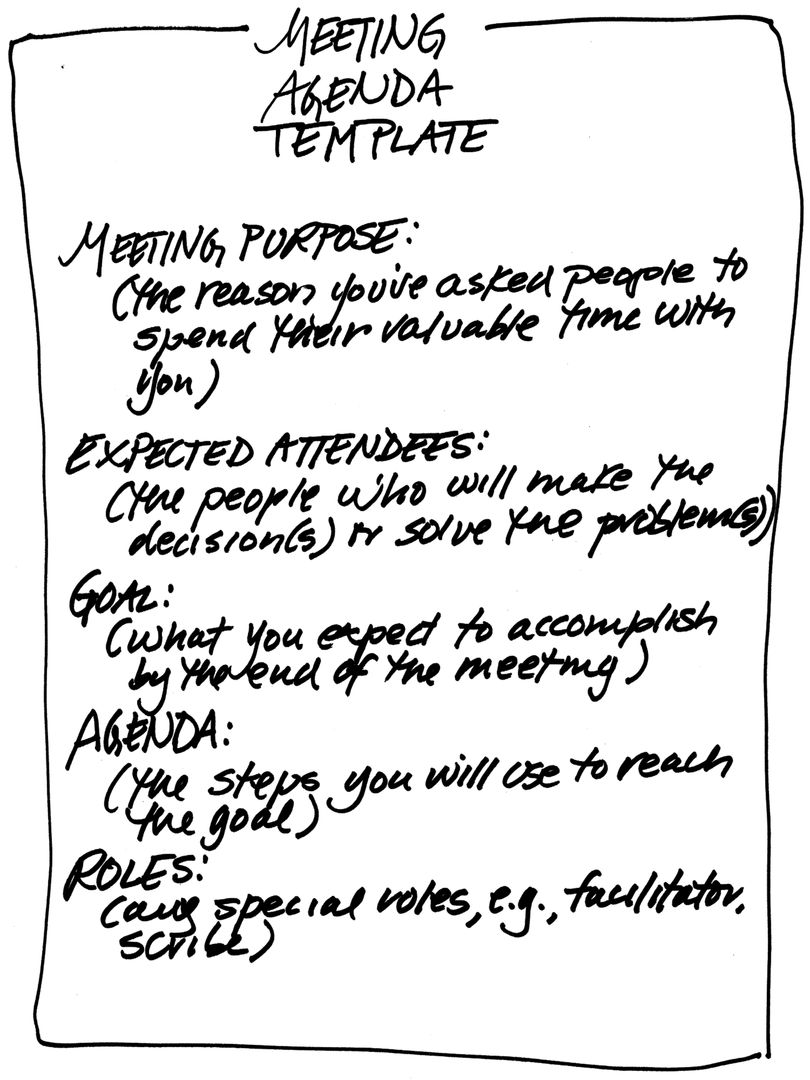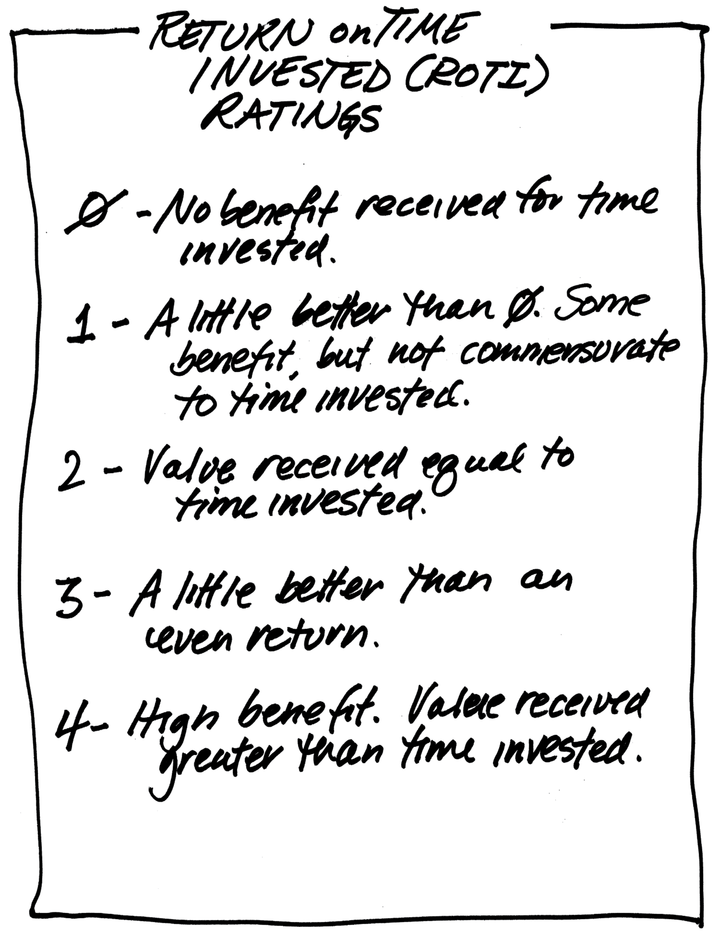Technique: Run Effective Meetings
General Meeting Tips
Meetings can be an effective way to accomplish group work. But meetings have a bad reputation, largely because there are so many bad meetings. It doesn’t have to be that way. Most companies could realize significant productivity gains—without fancy methodologies and high-priced consultants—if they put only a little effort into improving their meetings.
Figure 17, Meeting organization template shows our template for organizing a meeting.
Each Role in the figure describes how people may participate. You may require a facilitator, a moderator, a scribe, or a timekeeper. If you will be requesting that people serve specific roles, this is where you define them.

Figure 17. Meeting organization template
Guidelines
Meetings create value when people do the following:
-
Plan work.
-
Solve problems.
-
Reach decisions.
-
Share pertinent information.
-
Provide answers to questions.
If there’s no specific purpose for a particular meeting, the meeting serves no purpose. Cancel it.
- Use meetings for multidirectional exchange of information.
-
Serial status reporting—where several people working on largely independent initiatives report status to a manager—aren’t multidirectional exchanges. Serial status reporting may appear to save time for the manager, but wastes everyone else’s time. And because everyone is so disgusted with the meeting, they complain about it before and after. That’s a waste of time for everyone.
Make sure the right people are in the room (and only the right people are in the room). One of the reasons so many meetings are a waste of time is that either:
a) the group attempts to plan or make a decision without the people needed to provide information or represent interests or
b) there are too many people who represent peripheral interests.
Issues and problems that are vital to the organization’s interests provoke interest. Many people who are interested but not accountable for the outcome will want to attend. When the organization trusts that other people can arrive at reasonable decisions, they won’t feel compelled to attend; they’ll know they’ll receive pertinent information in a timely fashion.
But before people learn that trust, it’s not always possible (or even politic) to exclude interested people from the room. The most effective way to handle people who are interested but not accountable is to give them a formal role.
- Create a formal Observer role.
-
Observers attend meetings to listen and learn, not participate. Emphasize the difference in their role by having them sit away from the meeting table.
If an Observer insists on participating, take one of these actions:
-
Explain how the meeting outcome will be communicated and ask them (politely) to leave.
-
Clarify meeting roles, rules, and outcomes at the beginning of the meeting. Clarify who owns the final decision and who provides input.
-
Adjust the process to take their input into consideration.
-
Allow them to participate fully—meaning that they take action items and share accountability.
If Observers persist in interruptions, even while they insist on remaining in an Observer role, insist that the Observer leave.
- Create an agenda.
-
The agenda is the plan for accomplishing the goal of the meeting. Like all plans, you may not follow it exactly—adjust based on new information that surfaces in the meeting.
- Keep meetings short.
-
We recommend you keep meetings to an hour or less. If you think you need more time, ask yourself if you’re trying to accomplish too many goals in one meeting. Remember, people’s attention flags during meetings longer than an hour.
- Distribute the purpose, agenda, and expected outcomes prior to the meeting.
-
Allow people sufficient time to prepare if preparation is necessary for the meeting. Review and ratify the agenda at the start of the meeting. Allow people to add items or change the priority.
- Use a flip-chart page or an agenda on a whiteboard to create the focus for the meeting.
-
Use a template like the one in Figure 17, Meeting organization template, to hold the main information about the meeting. Post it in the meeting space so everyone can see the pertinent information at all times. If all the agenda items you need to cover in an hour won’t fit on a page using the template above, pare down the agenda or allocate more time.
- Capture key information during the meeting.
-
Take notes during the meeting. Notes that everyone can see are most effective. Use a flip chart or whiteboard to capture key points, action times, open issues, and decisions. Some people think it’s overkill to write notes on a flip chart or whiteboard. But we’ve seen too many meetings where each person diligently took private notes—and everyone left the room with a different sense of what happened.
- Review outcomes.
-
At the end of the meeting, review action items, decisions, or other outcomes. Determine how the group will follow up on action items. Without a follow-up step, action items are inaction items.
- Distribute notes after the meeting.
-
Transcribe and distribute notes within a day of the meeting. Everyone—core participants and interested parties—should receive notes.
- Plan to improve.
-
At the end of every meeting, gather data about how valuable the meeting was for the participants. Use a subjective measure such as Return on Time Invested (ROTI).The Roti Method for Gauging Meeting Effectiveness [Der03b]
Using a five-point scale, ask people to report how much value they received for the time they invested in the meeting (see Figure 18, Return on investment votes).

Figure 18. Return on investment votes
Post the ratings on a flip chart, and poll the group. Create a histogram that shows the results. An example histogram is shown in Figure 19, Return on investment histogram.

Figure 19. Return on investment histogram
Then ask for information about what made the meeting worthwhile or not worthwhile.
Ask the people who rated the meeting 2 or above what specifically they received for investing their time in the meeting.
Ask people who voted 1 or 0 what they wanted but didn’t receive for their investment.
Ask what to keep, what to drop, and what to add for the next similar meeting.
A meeting where a majority of the participants rate the meeting an even return for their time invested is a pretty good meeting.
Ratings below 2 may indicate that there wasn’t a match between the people and the purpose, or it may mean the meeting wasn’t run well. The additional data gathering should tell you an idea where to improve.
Run Effective Team Meetings
Team meetings help you solve problems and work together as a team, not as a bunch of individuals. Plan on conducting a general team meeting once a week—as long as you have a problem to solve or need to share information among everyone in the group. Make sure your team meetings do not devolve into serial status meetings.
Template:
-
Gossip, Rumors, News
-
Problem-of-the-week (the problem you will work as a team this week)
-
Review action items
Guidelines
We use the same topic headings, but the content will change week-to-week.
-
An hour is usually sufficient for this sort of meeting, but you may need more time if you’re working on a significant problem.
-
Avoid times when people are likely to be sleepy, tired, or ready to leave for the weekend.
-
Here are the reasons we ask for rumors, gossip, and good news:
-
Asking for rumors and gossip reduces the power to distract people by making them explicit. Once you are aware of the rumors and gossip, you can fill in the blanks with the real information.
-
Rumors and gossip are an excellent indicator of the mood of the organization, particularly when the organization is under stress.
-
Sharing good news helps improve morale.
-
-
Never ask for individual status in this setting. Individual status is for one-on-ones. Asking for individual status in a group meeting wastes everyone’s time. This is different from asking about status on action items that affect the group.
-
Focus on solving problems the group needs to solve together. If you’re not sure what your group problems are, you can do the following:
-
Ask the group to brainstorm their current list of problems.
-
Review your mission and goals (or, define them).
-
Brainstorm ways your team can be more effective in their work.
-
-
We recommend team meetings be at the same time and location every week. This will help your team form a rhythm of working together.
-
Track group-required action items, and work with people individually to monitor their progress and help them, if required.
For an interdependent team, using a fifteen-minute daily stand-up meetingAgile Project Management with Scrum [Sch04] can be very effective. In a daily stand-up, each team member answers three questions:
-
What did you do since our last meeting?
-
What will you work on today?
-
What is getting in your way?
The purpose of a daily stand-up is for the team to communicate and commit to each other; ideally, they will direct their answers to each other, not to you, the manager. Keep the meeting short by answering only these three questions. Problem solving happens after the stand-up.
